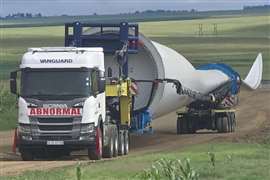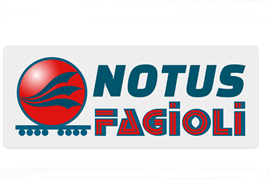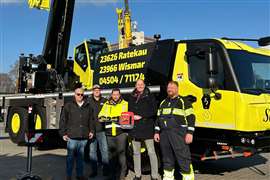Lattice boom crawler crane market: complicated but strong
07 July 2025
The lattice boom crawler market is strong in the USA but market uncertainty looms.
 As the sun sets, a huge number of Bigge Crane and Rigging lattice boom crawlers work at an LNG facility on the US Gulf Coast
As the sun sets, a huge number of Bigge Crane and Rigging lattice boom crawlers work at an LNG facility on the US Gulf Coast
The most accurate description of the lattice boom crawler crane market in North America is “it’s complicated.” In general, the crawler crane market is stable, if not strong. Ample projects that are ideal for crawlers are underway or in the start-up phases.
But potential and real economic challenges are a cause of concern, complicating the market and making it hard to predict how things will play out.
With close to 400 units, Bigge Crane and Rigging has the second largest crawler crane fleet in North America. Bigge’s cranes are working on jobs throughout the USA, according to Joe Nelms, chief revenue officer for the San Leandro, California-based company.
“The current market is relatively strong and we’re optimistic about the outlook for the next number of years,” Nelms said.
Strong demand
Bigge is constantly refreshing its fleet to meet current and future needs, and Nelms is optimistic.
“Bigge is seeing good demand throughout our product range, which goes from 110 tons up through 1,200 tons,” Nelms said. “We expect utility to be clicking along at current rates and likely improving over the next several years.”
Bigge is seeing “strong demand” from large manufacturing facilities, data centers, petrochemical plants, power plants, wind power and the like.
Nelms said there are market challenges, mainly to do with rising costs.
“Freighting crawlers to remote locations [is a challenge.]” he said. “Transportation costs are extremely high, especially in the western states.”
Rental rates for crawlers are bound to rise because of higher costs.
“I expect to see rental rates continue to go up as utility increases, manufacturers continue to raise prices, tariff impacts settle-in and the cost of labor, parts and transportation rise,” Nelms said.
Manufacturer perspective
From the manufacturer perspective, the crawler market is a difficult one to assess, mainly due to tariffs and regulatory issues.
While he describes the current market as “stable,” Jim Jatho, product manager for lattice boom crawler cranes for Liebherr USA, said that the uncertainty of certain market segments has been a problem.
“The lackluster performance of the offshore wind market has hurt the potential for large crawlers,” he said. “Onshore wind is strong with maintenance and repower work, but new installation has been slow due to the cancellation of clean energy incentives from the government.”
Tariffs are also a major challenge considering the high price tag of a crawler crane, Jatho said. Does he anticipate things will get better or worse over the next year?
“This is another area of uncertainty, and will largely depend on decisions made by the current administration,” he said. “The renewable energy market could be in decline, but there is also a new push for nuclear energy, which could be a huge boost to the crawler market. Large infrastructure projects such as major sports stadiums are also on the radar as a consumer of large crawler cranes.”
Jatho said the LR 1500 and LR 1700 are the highest demand models.
“For the LR 1500 and 1700, wind maintenance and repower work is the biggest driver currently,” he said. “For larger cranes, massive AI data centers and chip processing plants have been a big driver of utilization.”
Healthy and positive
Overall, the crawler crane market is healthy and positive, according to Manitowoc Cranes’ product manager Brennan Seeliger.
“There’s a stable level of ongoing work across end markets, which is driving a diverse and steady demand for machines of different sizes and capabilities,” he said. “Current U.S. trade policy is impacting our ability to source materials cost effectively and in a timely manner. This is leading to increased manufacturing costs and extended lead times for both machines and spare parts.”
Despite these issues, he expects the market to remain relatively stable over the next year.
“There are several unknowns in the broader economy, so our outlook remains cautiously optimistic,” Seeliger said.
Manitowoc said it has seen strong demand for all its crawler products.
“Our newly released MLC200 has generated significant interest. Infrastructure work is fueling demand for smaller crawlers, particularly for highway and bridge-related projects, while warehouse construction and large-scale general building projects are driving customer interest in mid-size and large machines. Major infrastructure and energy projects continue to drive demand for high-capacity crawlers.”
Each end market has its own set of requirements, which is creating demand across multiple crane classes, Seeliger said. For this reason, customers prioritize reliability and strong product support, he said.
“Customers are seeking machines that deliver consistent performance and are easy to maintain,” Seeliger said. “Since acquiring several distribution channel territories in 2021 as part of our Cranes+50 strategy, Manitowoc has made significant investments to get closer to customers by enhancing service support by continually increasing service technicians in the field and expanding branch locations, ensuring customers experience maximum uptime and minimal operational disruptions.”
The tariff question
The market for the capacity classes Tadano services is on the uptick, according to Allen Kadow, product manager for telescopic and lattice boom crawler cranes.
“2024 was an election year and we saw a slight downturn in the market, but it appears to be rebounding in 2025,” he said. “The tariff situation may slow the market until things settle and come to an equilibrium.”
Kadow said the uncertainty caused by the tariff issue is the biggest challenge for the market, and he said predicting market conditions will be difficult until the tariff situation is worked out.
“At this time, the 400-metric ton and 650-metric ton classes are most popular for Tadano,” Kadow said. “As always for large lattice crawlers, they are popular for general construction, infrastructure, petrochemical, power plant construction and wind energy.”
Tadano customers are looking for reliability, efficiency, ease of operation and assembly and quality.
Cautious optimism
Michael Dawson, Link-Belt’s product manager for lattice and telescopic crawler cranes, characterizes the lattice boom crawler market as evolving.
“Earlier this year, the market was moving forward, equal to last year’s market with some categories a little up and others a little down,” he said. “But overall, a flat to slightly increasing market was on the horizon. However, with the announcement of tariffs on goods coming to the United States, I think it put lattice crawlers and perhaps other products in a state of cautionary pause. At least it did for us. I cannot speak for others, but we will move forward cautiously and await a more definitive policy.”
With much of the crawler crane supply coming from overseas, the biggest concern is the tariffs themselves regarding what the final percentage tariff will be and how buyers will react to that new pricing, he explained.
“Prior to the tariffs, I would’ve said the market will improve,” Dawson said. “Being an eternal optimist and seeing the workload on contractor’s schedules in 2026, I think you have to form a best-case, worst-case scenario going forward and plan your business somewhere between those two points.”
Good news for Link-Belt is that there is an active market across the board for crawlers from 80 to 300 tons.
“Very recently, we’ve had a good bit of small crawler activity to go with our medium and large products,” he said. “In turn, we really see good demand bottom to top. Infrastructure projects are probably the highest in demand along with a steady oil field exploration demand.”
Well positioned
Sany America crawler crane project manager Joel Hicks has a positive outlook on the crawler market.
“The lattice crawler crane market is growing and was up about 25 percent in 2024 compared to 2023,” he said. “It has rebounded from the 2020 Covid year with continued yearly growth. My long-term outlook on the lattice crawler market is positive, but there will be some short-term effects on the market from tariffs. While the overall crawler crane market is up, the demand for 400-plus ton lattice crawlers seems to have weakened.”
Sany is seeing strong demand for the 110-ton SCA1000A and 150-ton SCA1350A. Precast construction is driving demand for Sany’s 300-ton SCA2600A lattice crawler, Hicks said.
“Infrastructure projects, especially road and bridge improvements, seem to be fueling the biggest demand for lattice crawler cranes in the 110 to 250 ton range,” Hicks said. “Precast construction and data centers are causing high demand for the lattice crawlers in the 150-ton to 350-ton market. Wind energy projects seem to have slowed as demand for 400-plus ton crawlers is weak.”
Currently, the biggest challenge is the uncertainty created by the tariffs.
“Both customers and manufacturers are in a holding pattern waiting to see how the tariffs shake out,” he said. “High interest rates are forcing some customers to hold off on purchasing new cranes and look at other alternatives like renting or purchasing a used crane.”
Sany customers want a safe and reliable crane this is easy to transport and quick to assemble, Hicks said.
“Self-assembly is becoming a must-have feature as it reduces the expense of an assist crane,” he said. “Customers expect lattice crawlers to be versatile and have strong load charts that offer long reach with additional attachments like fixed jib and luffing jib. The crane must be easy to maintain and have strong parts and service support as downtime is very costly. Stability and pick and carry capabilities or other attributes that are important with customer.”
Following is an overview of popular crawler cranes distributed in North America.
Tadano CC 78.1250-1
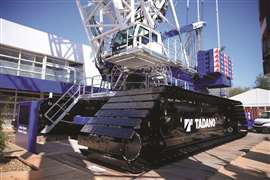 Capacity: 1,375 tons (1250 mt) Fixed Jib: 49 to 137 feet (15 to 42 meters) Luffing Jib: 118 to 374 feet (36 to 114 meters) Main boom: 118 to 687 feet (36 to 209.5 meters)
Capacity: 1,375 tons (1250 mt) Fixed Jib: 49 to 137 feet (15 to 42 meters) Luffing Jib: 118 to 374 feet (36 to 114 meters) Main boom: 118 to 687 feet (36 to 209.5 meters)
At Bauma in April, Tadano introduced the 1,275-ton capacity CC 78.1250-1. Building on the performance of the CC 68.1250-1, the new crane incorporates advancements in performance, safety, efficiency and transportability.
Designed to meet the demands of heavy lift applications, including wind turbines, the CC 78.1250-1 achieves a maximum hook height of 736.5 feet when fitted with a 49.2 foot fixed jib. In this configuration it can lift 154.3 tons. To improve its stiffness, the width of the base crane was increased to 11.5 feet. The two available crawler shoe widths – 6.6 feet and 7.9 feet – can accommodate varying ground pressure requirements.
Tadano’s CC 78.1250-1 is designed to offer multiple redundancies maximizing uptime and enhancing safety, the company said. The crane features a dual-engine arrangement with an optimized hydraulic system, allowing for single-engine operation at reduced speeds. The optional auxiliary power unit enables cab systems, HVAC and lighting to operate using a 22.8 HP diesel engine, reducing fuel consumption and emissions during standby operation.
Tadano’s Allen Kadow said Tadano prioritizes safety, and the CC 78.1250-1 offers multiple features designed to enhance operator confidence and job site security. It has the Tadano Fall Protection System and incorporates protective access to the superstructure and the undercarriage, including improved handrails, catwalks and access ladders. The cab provides an expanded field of view, and an array of cameras and mirrors help the operator see the hoist drums and other blind spots around the crane.
“In our ever-changing industry, Tadano remains committed to delivering lifting solutions that combine reliability, efficiency and sustainability,” Kadow said.
Link-Belt 348 Series 2
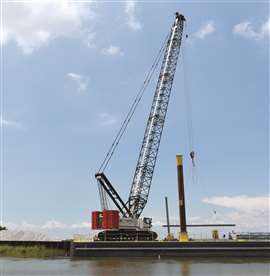 Capacity: 300 tons Fixed Jib: 40 to 140 feet Luffing Jib: 180 feet plus 240 feet Main boom: 70 to 300 feet (Heavy Duty) 85 to 355 feet (Long Range)
Capacity: 300 tons Fixed Jib: 40 to 140 feet Luffing Jib: 180 feet plus 240 feet Main boom: 70 to 300 feet (Heavy Duty) 85 to 355 feet (Long Range)
The 348 Series 2 is Link-Belt Cranes’ 300-ton capacity lattice boom crawler crane, designed for heavy lift operations and job site flexibility. It offers a 70 to 300-foot heavy-duty boom configuration or an 85 to 355-foot long-range boom option. A luffing attachment adds even greater reach, allowing a maximum combination of 190 feet of main boom and 240 feet of luffing jib, along with fixed jib lengths from 40 to 140 feet. Complementing the crane’s sturdy tubular boom is the heavy-duty combo top, which accommodates luffing and fixed jib configurations, eliminating the need for separate boom tops, streamlining job site operations, according to Dawson.
A quiet, HVO-compliant 320-horsepower Cummins Tier IV Final engine powers high-capacity winches, enabling pick-and-carry capabilities across the 360-degree load chart. Simple and efficient setup and teardown features are built into the machine’s design such as easy hook-and-pin side frames, bar pendants that slide into integrated storage brackets on the lattice boom and a luffing attachment with front and rear posts that fold into the base section for single-piece transport. The 17-piece modular counterweight system features a remote-controlled hydraulic removal system and a self-assembly cylinder integrated into the live mast.
With reach, capacity and mobility, the 348 Series 2 excels in bridge building, steel erection, tilt-up work and pick-and-carry applications, Link-Belt said.
Manitowoc MLC200
 apacity: 200 tons (181 metric tons) Luffing Jib: Up to 315 feet Main boom: 78.7 to 315 feet (24 to 96 meters)
apacity: 200 tons (181 metric tons) Luffing Jib: Up to 315 feet Main boom: 78.7 to 315 feet (24 to 96 meters)
The Manitowoc MLC200 is a lattice boom crawler crane built for modern jobsite needs, offering 200 tons (181 metric tons) of lifting power, according to Manitowoc’s Brennan Seeliger. As one of the newest additions to Manitowoc’s MLC lineup, the MLC200 is designed to maximize versatility, ease of transport, and operator confidence, all while providing strong returns on investment through enhanced uptime and lower operating costs, the company said.
With a main boom length ranging from 78.7 to 315 feet (24 to 96 meters), and luffing jib options that extend up to 315 feet, the crane is ideally suited for infrastructure, energy and large-scale commercial construction projects, Seeliger said. It features Manitowoc’s CCS (Crane Control System), to offer precise and consistent control, improved diagnostics, and greater operator comfort.
The MLC200 also focuses on simplified transport and assembly. Its design minimizes component weights and shipping requirements, helping contractors reduce mobilization costs and meet tight project schedules. Setup is further streamlined with self-assembly capabilities and intuitive controls.
“From its class-leading reach and capacity to its ease of use and reliability, the Manitowoc MLC200 delivers powerful performance for a wide range of lifting applications” said Seeliger.
Liebherr LR 1500
Marking a decade since its debut at Customer Days 2015 in Ehingen, Germany, Liebherr’s LR 1500 has been one of its most successful crawler cranes. Designed with simplicity and savings in mind, the LR 1500 ensures effortless operation and cost-effective performance, according to Liebherr’s Jim Jatho.
With a lifting capacity of 550 tons (500 metric tons), a maximum hoist height of 538 feet (164 meters) and a radius up to 472 feet (144 meters), the crane is said to be extremely compact and can be transported easily anywhere in the world. Additionally, the standard track pads on the LR 1500 are 5 feet (1.5 meters) wide, greatly reducing ground pressure.
The LR 1500 comes equipped with a six-cylinder inline engine and meets the emission regulations of Stage IV/Tier 4f. Other purchasing criteria of many customers include the very high load capacities of the LR 1500, whilst it retains its compact size compared to its predecessor, the LR 1400/2. The load capacities have been increased by an average of 28 percent on the 275 foot (84 meter) main boom.
Movements start smoothly with the LR 1500’s powerful main hoist winch, which handles all lifts to the maximum load capacity. This makes crane operation easier since there is no need for parallel winch operation for heavyweight lifts. Additionally, the derrick boom is 98 feet
(30 meters) long and the derrick ballast is up to 286 tons (260 metric tons). The ballast for the LR 1500 consists of the 11-ton (10 metric ton) plates which are also used on other Liebherr machines. This is a low-cost solution for crane operators with several cranes of these types in their fleet.
“A decade later, the LR 1500 continues to set benchmarks in performance and versatility, reinforcing Liebherr’s commitment to innovation and excellence in crawler crane engineering,” Jatho said.
Sany SCA1350A
 Capacity: 150 tons Fixed Jib Length: 42.7 to 101.7 feet Luffing Jib Length: 72.2 to 170.6 feet Main boom: 52.5 to 249.3 feet
Capacity: 150 tons Fixed Jib Length: 42.7 to 101.7 feet Luffing Jib Length: 72.2 to 170.6 feet Main boom: 52.5 to 249.3 feet
The Sany SCA1350A is a robust lattice boom crawler crane that is particularly suited for the North American market, according to Sany’s Joel Hicks. It offers a lifting capacity of 150 tons at a 15-foot radius. It is powered by a Cummins QSL9-C325 diesel engine. Operational versatility is highlighted by boom and jib configurations: a main boom length variable from 52.5 to 249.3 feet, a fixed jib ranging from 42.7 to 101.7 feet and a luffing jib spanning 72.2 to 170.6 feet. The longest main boom with a fixed jib is 200.1 feet plus 101.7 feet, while maximum main boom with luffing jib combination is 160.7 feet plus 170.6 feet.
Key features include self-assembly via wired remote, a 10.4-inch color touchscreen LMI display providing real-time data. Operator comfort and safety are prioritized with a spacious 20-degree tiltable cab with large suspension seat and ergonomic controls.
“All our cranes have a mechanical hydraulic lock lever and seat interlock switch that disables hydraulic functions once the operator leaves the seat,” said Hicks. “Additional standard safety features include tricolor light bar, 3rd wrap kickout, full length boom walkways, anemometer, aircraft light and ATB switches.
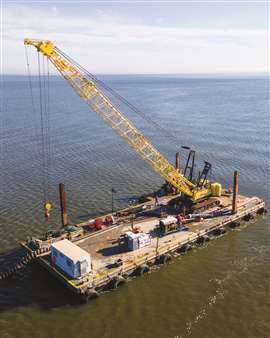 Capacity: 160 tons Fixed Jib: 100 feet w/ max combination of 200 feet of main boom plus 100-foot fixed jib Luffing Jib: 175 feet w/max combination of 157 feet of main boom plus 175-foot luffing jib Main Boom: 250 feet
Capacity: 160 tons Fixed Jib: 100 feet w/ max combination of 200 feet of main boom plus 100-foot fixed jib Luffing Jib: 175 feet w/max combination of 157 feet of main boom plus 175-foot luffing jib Main Boom: 250 feet
The Kobelco CK1600G-3 is designed for reliable operation, convenient maintenance and easy transport, according to Jimmy Hodges, Kobelco’s general manager of cranes.
“The CK1600G-3 features a new Isuzu engine that complies with the latest EPA Tier IV standards,” he said. “The cranes are equipped with an energy saving assist systems known as G-modes.”
The “G-modes” include the auto idle stop system, energy saving winch control system and the engine RPM limitation system. Other re-design features of the new G-3 series include compact structure allowing for greatly improved transportability, larger cab design, LMI touch screen, counterweight detection device, improved counterweight self-installation mechanism and newly improved (short) control levers.
Kobelco is renowned for smart engineering and a focus on creating the best value package for lifting solutions, according to Hodges.
STAY CONNECTED


Receive the information you need when you need it through our world-leading magazines, newsletters and daily briefings.
CONNECT WITH THE TEAM










